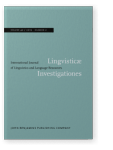The predicative adjective and its propositional arguments
A lexicon-grammar classification
The purpose of this paper is to classify Italian adjectives that have the predicative function and accept a
complement clause (Ch F) or an infinitive (V-inf) in N0
or
N1
. For the formation of the word list, we have used electronic dictionaries from the “DELA”
system in use in the Department of Communication Sciences at the University of Salerno (now Department of Political and
Communication Sciences) and De Mauro Dictionaries (2000a and 2000b).
34,132 adjectives of the Nooj list have been examined. The acquired data have been subjected to further
verifications in order to obtain the adjectives responding to the basic theoretical hypothesis. The adjectives have been
classified according to the principles of Lexicon-Grammar methodology as developed by Maurice Gross (1975, 1981 and further). The result was a list of 1,732
entries relating to 1,619 adjectives classified in 10 classes.
Article outline
- 1.The arguments of the predicative adjective
- 2.The construction SN essere Agg
- 3.Classification
- 4.
Ch F and V-inf as a propositional subject of the predicative adjective
- 4.1Ap1a = N0 V → (Ch F + V-inf)0 essere Agg
- 4.2Ap1b = N0 V → Ch F0 essere Agg
- 4.3Ap1c = N0 V → V-inf0 essere Agg
- 4.4Ap2 = N0 V Prep N1 → (Ch F + V-inf)0 essere Agg Prep N1
- 5.The structure N0 essere Agg (E + Prep) N1
- 5.1Ap3 = N0 V Prep N1 → Num0 essere Agg ((del fatto) Ch F + di V-inf)1
- 5.2Ap4 = N0 V Prep N1 → (Num + N-um)0 essere Agg a (Ch F + V-inf)1
- 5.3Ap5 = N0 V Prep N1 → ((Il fatto) Ch F + V-inf)0 essere Agg (simm) Prep ((Il fatto) Ch F + V-inf)1
- 5.4Ap6 = N0 V Prep N1 → (Num + N-um + il fatto (Ch F + di V-inf))0 essere Agg Prep il fatto (Ch F + di V-inf)1
- 6.ApFI - Definitional structures of indirect interrogative clauses
- 7.A short final note
- Notes
-
Selected references
References
Selected references
Acquaviva, P.
1991 Frasi argomentali: completive e soggettive. In
L. Renzi e
G. Salvi (eds.),
Grande grammatica di consultazione, vol. II1, 633–674. Bologna: Il Mulino.

Borillo, A.
1971 Remarques sur les verbes symétriques français.
Langue française, 111, 17–31.


Chomsky, N.
1964 Current issues in linguistic theory. Mouton: The Hague.

D’Agostino, E.
(
1993)
Sociolinguistica computazionale. Un’applicazione al corpus di frequenza dell’italiano parlato. Salerno: 10/17.

De Mauro, T.
2000a Il dizionario della lingua italiana. Torino: Paravia.

De Mauro, T.
2000b Grande dizionario italiano dell’uso (GRADIT). Torino: Utet.

Elia, A.
1984,
Le verbe italien. Les complétives dans les phrases à un complément. Fasano-Paris: Schena-Nizet.

Fava, E.
1977 Alcuni problemi di una regola di promozione nella grammatica relazionale.
Rivista di Grammatica Generativa, 87–124 (
[URL])
Giry-Schneider, J.
2017 Sintassi nascosta degli aggettivi. Spunti dal francese. Pisa: ETS.

Gross, M.
1975 Méthodes en syntaxe. Paris: Hermann.

Gross, M.
1981 Les bases empiriques de la notion de predicat semantique.
Langages, 15(63), 7–52.


Gross, M.
1996 Les verbes supports d’adjectifs et le passif.
Langages, 30 (121), 8–18.


Gross, M.
1998 La fonction sémantique des verbes supports.
Travaux de Linguistique: Revue Internationale de Linguistique Française, 37 (1), 25–46.

Harris, Z. S.
1976 Notes du cours de syntaxe. Paris: Editions du Seuil.

Harris, Z. S.
1981 Papers on syntax. Dordrecht: Reidel.


Harris, Z. S.
1982 A Grammar of English on Mathematical Principles. New York: Wiley & Sons.

Hicks, G.
2009 Tough-constructions and their derivation.
Linguistic Inquiry, 40 (4), 535–66.


Lasnik, H. & Fiengo, R.
1974 Complement object deletion.
Linguistic Inquiry, 5 (4), 535–71.

Manzini, M. R. & Savoia, L. M.
2003 The nature of complementizers.
Rivista di Grammatica Generativa, 281, 87–110.

Meunier, A.
1999 Une construction complexe N0hum être Adj de V0-inf W caractéristique de certains adjectifs à sujet humain.
Langages, 33 (133), 12–44.


Picabia, L.
1978 Les constructions adjectivales en Français. Genève: Librairie Droz.

Postal, P.
1971 Cross-over phenomena. New York: Holt, Rinehart, & Winston.

Riegel, M.
1985 L’adjectif attribut. Paris: Presses universitaires de France (P.U.F.).

Riegel, M.
1997
Il est gentil de nous avoir aidés ou à propos de compléments de l’adjectif qui n’en sont pas vraiment. In
G. Kleiber et
M. Riegel (éds)
Les formes du sens: études de linguistique française, médiévale et générale offertes à Robert Martin à l’occasion de ses 60 ans, 355–65. Louvain-la-Neuve: Duculot.

Rosenbaum, P. S.
1967 The grammar of English predicate complement constructions. Cambridge, MA: MIT Press.

Tesnière, L.
1959 Éléments de syntaxe structural. Paris: Librairie C. Klincksieck.

Cited by
Cited by 1 other publications
Yinghua, Wu, Meng Shaoxiu, Wang Juan & Jun Ye
2022.
Attribute Feature Classification of English Grammar Entry Base Based on Support Vector Machine Classification Algorithm.
Computational Intelligence and Neuroscience 2022
► pp. 1 ff.

This list is based on CrossRef data as of 5 july 2024. Please note that it may not be complete. Sources presented here have been supplied by the respective publishers.
Any errors therein should be reported to them.
